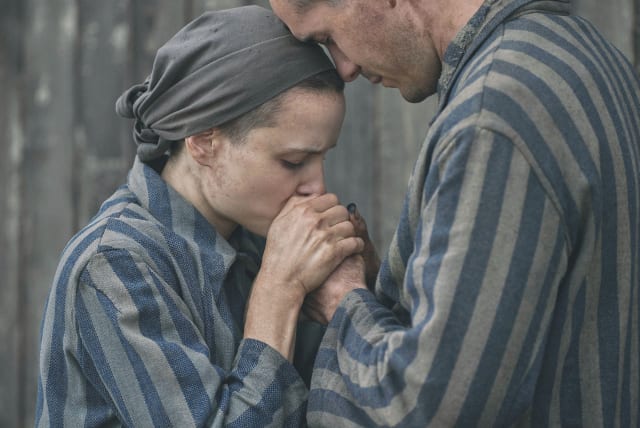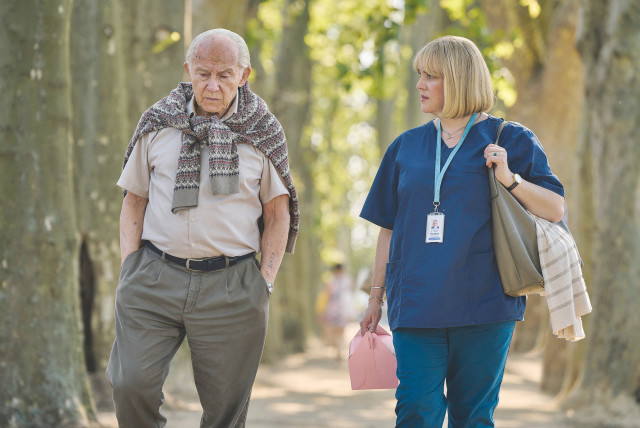Ahead of Holocaust Remembrance Day, 'The Tattooist of Auschwitz' hits Israeli TV

The Tattooist of Auschwitz is more visually accurate than many other Holocaust dramas, with inmates looking disheveled and dirty. The violence is also appropriately graphic.
The Tattooist of Auschwitz, the new series from Peacock that became available on Hot and Yes on May 2, is powerful and well-acted, focusing on a unique story from the Holocaust.
It’s based on the bestselling novel of the same name, which was inspired by author Heather Morris’s conversations with Lale Sokolov, a Holocaust survivor from Slovakia who settled in Australia after the war.
It stars Harvey Keitel as the elderly Lale, telling the story of his life to Heather (Melanie Lynskey of Yellowjackets), a nurse who wants to become a writer, while Jonah Hauer-King plays Lale as a young man. The director is Israeli, Tali Shalom-Ezer, who was also an executive producer on the series.
A graphic and visually accurate Holocaust drama
You may have read about controversies concerning the veracity of the book raised by certain Holocaust research organizations, but they seem to be mainly over very minor inconsistencies, such as whether the number a certain character is tattooed with is accurate. If they are mistakes, they are small, honest mistakes and should not discourage anyone from watching this series.
The framing device is that Lale, an elderly widower who lives alone in Australia, has decided he wants someone to write his life story. Heather, a Christian nurse who knows little about the Holocaust, is eager to try. It’s really more than just a framing device because there are many scenes about how the trauma of the Holocaust affects Lale in the present, and also how hearing his story affects Heather.
It’s an effective way into the story since it allows Heather to ask the questions audience members who know little about the Holocaust might have, and Keitel and Lynskey are extremely good in all their scenes together.
Keitel grew up in Brooklyn just after the Holocaust and his performance has a feeling of authenticity, with flashes of humor and playfulness, as if he is channeling Holocaust survivors he remembers. He shows how Lale himself, even after decades, can’t quite believe all the horrors he witnessed, or the turns of fate that got him through it.
Keitel, who recently played the infamous Jewish gangster in the movie Lansky, is doing some of his best work now that he is well into his 80s.
“THIS IS a love story,” Lale tells Heather early on, and his love for a fellow Slovakian inmate, Gita (Anna Prochniak) is at the heart of his tale. “I have good things to tell you as well [as sad ones]... and good things take time.”
His story begins in Slovakia in 1942 when he is working at a store and not terribly concerned about the anti-Jewish regulations. That changes quickly when he loses his job and has to return to his family in the country. When each Jewish family is asked to send a member to what are described as labor camps, he volunteers to go and is sent directly to Auschwitz.
The film is in English and the actors speak in weird accents that are meant to sound like English speakers with Yiddish or Eastern European accents, except for the Nazis, who snarl in German-accented English. This is always distracting but I’ve come to accept, reluctantly, that the only way for Holocaust stories to get made in big-budget productions is to have the dialogue in English.
Ironically, Keitel starred as a vile Nazi in The Grey Zone, Tim Blake Nelson’s English-language Holocaust drama. Keitel is Jewish and married his wife, Daphna Kastner, a Canadian actress/director born to Israeli parents, in Jerusalem after attending the Haifa International Film Festival in 2001 to present The Grey Zone.
Even though it is in English, The Tattooist of Auschwitz is more visually accurate than many other Holocaust dramas, with inmates looking disheveled and dirty. The violence is also appropriately graphic.
It seems that, except for the English, the creators took the movie, Son of Saul, as their model. This Oscar-winning 2016 film by Laszlo Nemes is a very bleak, very violent movie in color (none of the tasteful black and white of Schindler’s List or many other Holocaust dramas) that is one of the most accurate and harrowing depictions of Auschwitz ever put on film.
Like the other recent series about the Holocaust, We Were the Lucky Ones, The Tattooist of Auschwitz aims for a tone that is as upbeat as possible under the circumstances. But it does not neglect to portray the constant threats and killings, both systematic, through the gas chambers, and random, as guards murder any inmate they want, whenever they want.
The main way it strives for positivity is through its portrayal of the romance between Lale and Gita, whom Lale meets as he tattoos her number on her arm, after he gets the coveted position as a tattooist.
Some might feel that being a tattooist is dangerously close to being a collaborator since the tattooists received perks such as better food and lodgings. But Lale uses his position to help Gita and her friends, one of whom is played by Israeli actress Mili Eshet.
At times, though, he is forced to help the Nazis as they torture inmates, although he does as much as he can to keep others out of harm’s way. “We must keep living and help others too, whatever it takes,” Gita tells him, and it’s clear that having another human being to care for helped keep both them alive by raising their spirits.
Lale becomes very close to an SS officer, Stefan Baretzki (Jonas Nay), who helps him steal moments with Gita, even while this Nazi kills other inmates. As Lale tells Heather his story, he becomes haunted by the tough choices he had to make to survive. Toward the end of his tale, he is presented with a striking dilemma, and the series also delves into problems Lale faced adjusting to a normal life after the Holocaust.
The series is also about how Heather is changed by getting to know Lale, and she even suffers a panic attack at one point. After this, she tells her husband, who suggests she may have become too stressed out from working on the book, “None of the things that Lale went through, none of it happened to me and to make it about me would be a bloody insult.”
If all this isn’t enough to make you want to watch Tattooist, it features a new Barbra Streisand song, the first she has released in six years, “Love Will Survive.”
In a statement, Streisand said, “Because of the rise in antisemitism around the world today, I wanted to sing ‘Love Will Survive’ in the context of this series as a way of remembering the six million souls who were lost less than 80 years ago. And also to say that even in the darkest of times, the power of love can triumph and endure.”
Jerusalem Post Store
`; document.getElementById("linkPremium").innerHTML = cont; var divWithLink = document.getElementById("premium-link"); if (divWithLink !== null && divWithLink !== 'undefined') { divWithLink.style.border = "solid 1px #cb0f3e"; divWithLink.style.textAlign = "center"; divWithLink.style.marginBottom = "15px"; divWithLink.style.marginTop = "15px"; divWithLink.style.width = "100%"; divWithLink.style.backgroundColor = "#122952"; divWithLink.style.color = "#ffffff"; divWithLink.style.lineHeight = "1.5"; } } (function (v, i) { });

